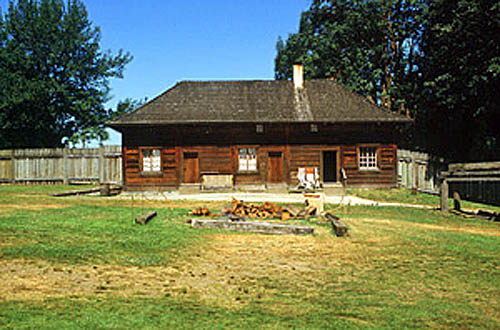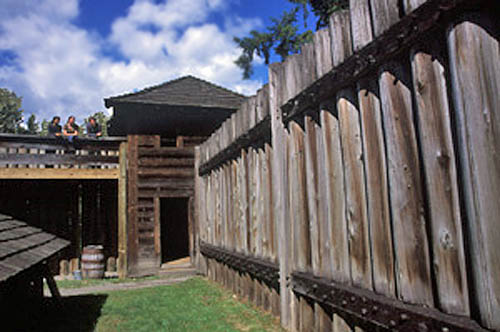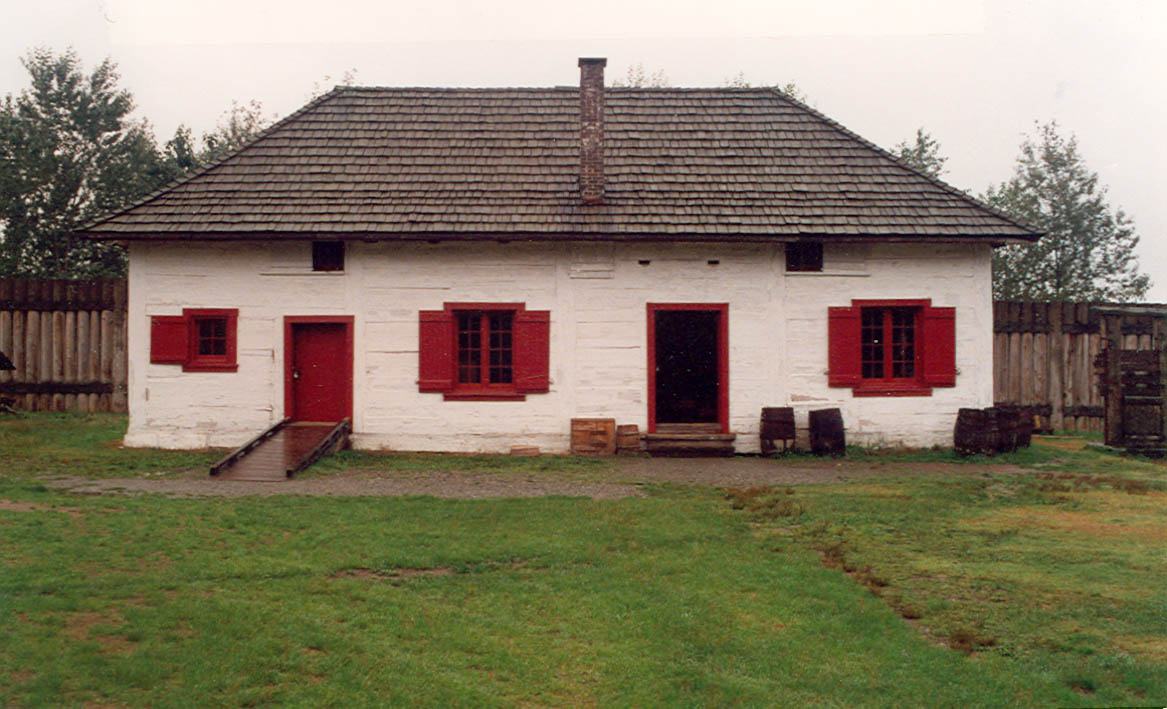Other Name(s)
Fort Langley National Historic Site of Canada
Fort Langley
Fort Langley
Links and documents
Construction Date(s)
1839/01/01 to 1840/01/01
Listed on the Canadian Register:
2007/06/19
 Statement of Significance
Statement of Significance
Description of Historic Place
Fort Langley National Historic Site of Canada is the site of a Hudson’s Bay Company post located on the south banks of the Fraser River approximately 48 km east of Vancouver. It contains an original log warehouse as well as several newer evocations of historic structures within a reconstructed wooden palisade. The site is interpreted and open to the public. The official designation refers to the associated buildings and landscape within the site’s boundaries.
Heritage Value
Fort Langley has been designated a national historic site because:
- it was founded in 1827 to drive off the fur-traders from Boston who had monopolized the Maritime trade;
- it was from Fort Langley, rebuilt in 1840 (sic 1839) further up the river, that the Hudson’s Bay Company began to export salmon, supplying the forts of the Company and the Sandwich Islands (Hawaii);
- after the abandonment of the Columbia River as a trade route in 1848, the Company forwarded their goods to Langley for transhipment to their forts in British Columbia; and
- the act creating the colony of British Columbia was proclaimed at Langley in 1858.
The heritage value of Fort Langley lies in its historical associations as illustrated by the site and surviving resources. Originally constructed in 1827 at a location 4 km upstream of its present site, the post was relocated and rebuilt in 1839, only to be destroyed by fire in 1840 requiring it to be, once again, rebuilt. The Hudson’s Bay Company continued to run a post on this site until 1886, although in later years its focus shifted from fur to agricultural trade and fish packing. Since it became a national historic site in 1923 the location of Fort Langley’s palisades have been identified through archaeological investigation, as have the remains of many of its buildings and structures. The site has gone through two major periods of expansion; firstly in the 1950s in conjunction with the provincial centennial celebrations, and again in the 1990s.
Sources: Historic Sites and Monuments Board of Canada, Minutes, May 1955; Commemorative Integrity Statement, October 2003.
Character-Defining Elements
Key features contributing to the heritage value of this site include:
- the siting on a small knoll above the banks of the Fraser River across from McMillan Island,
and behind a plain between the knoll and the Salmon River which provides access to Boundary Bay;
- its orientation to the remnants of other buildings within the fort and their central courtyard,
- its siting on the perimeter of the fort parallel with the palisade,
- the wholeness and coherence of the cultural landscape of the fort,
- the footprint of the palisades at its greatest extent and traces of its earlier location;
- the footprints as well as remnants and reconstructed profiles of buildings and structures inside the palisades of the fort;
- remnants of the foundations, former trenches, privies, storage pits and cellar depressions that remain on the site from the fur trade era, including their footprints and any evidence of their composition and materials;
- the functions and spatial relationships both individually and in relation to one another of the Storehouse building, palisade and central courtyard;
- the Storehouse building in its location and orientation, its single-storey rectangular massing and hipped roof; its irregular pattern of openings, surviving original materials (squared logs with a lime/mud wash), its pièce sur pièce construction technology, and remnants of early forms, finishes, and layout visible in the interior;
- archaeological artifacts, both above and below ground, representative of life in the fort during the fur trade era, including those that have been removed from the site and are stored by Parks Canada;
- viewplanes from the palisades to the Fraser River and McMillan Island, to the east, looking upriver towards the site of the earlier fort, and to the countryside and west towards the Salmon River;
- viewplane from the Fraser River to the fort.
 Recognition
Recognition
Jurisdiction
Federal
Recognition Authority
Government of Canada
Recognition Statute
Historic Sites and Monuments Act
Recognition Type
National Historic Site of Canada
Recognition Date
1923/05/25
 Historical Information
Historical Information
Significant Date(s)
1839/01/01 to 1886/01/01
1827/01/01 to 1886/01/01
Theme - Category and Type
- Developing Economies
- Trade and Commerce
- Governing Canada
- Government and Institutions
Function - Category and Type
Current
- Leisure
- Historic or Interpretive Site
Historic
- Commerce / Commercial Services
- Trading Post
Architect / Designer
n/a
Builder
n/a
 Additional Information
Additional Information
Location of Supporting Documentation
National Historic Sites Directorate, Documentation Centre, 5th Floor, Room 89, 25 Eddy Street, Gatineau, Quebec
Cross-Reference to Collection
Fed/Prov/Terr Identifier
66
Status
Published
Related Places

Servants' Quarters
The Servants’ Quarters, located along the west wall of Fort Langley is a one-and-a-half storey, rectangular structure. The building was erected with heavy timbers using the Red…

Northeast Bastion
The Northeast Bastion of Fort Langley, is a two-storey structure built of squared logs and topped with a slightly flared, pyramidal roof. It is located at the intersection of the…

Big House
The Big House is located at the south end of Fort Langley’s enclosure. The largest building at the Fort, it is a rectangular, log structure with a hipped roof and front verandah.…

Storehouse
Located in Fort Langley, the Storehouse is a simple, rectangular, one and a half storey building with a hipped roof on a post-on-sill structure. A utilitarian, small post…